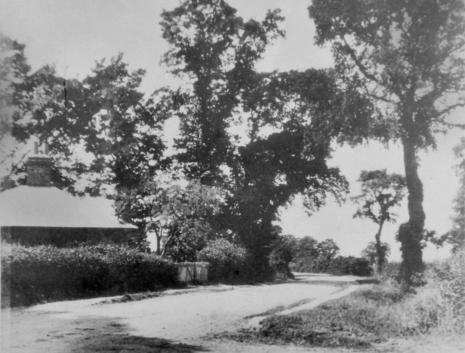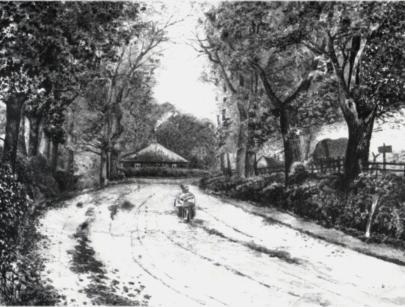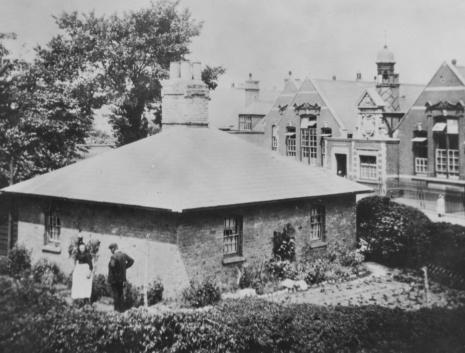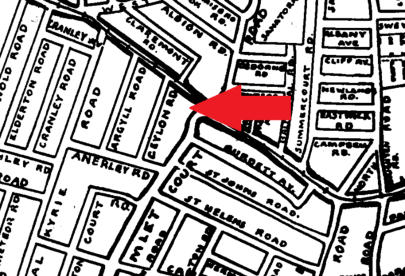Shepherd’s Cottage
Shepherd’s
Cot
(also
known
as
Dowsetts
Cottage,
Hamlet
Cottage
or
just
the
Cot),
was
a
small
single
storey
square
in
shape
building,
at
the
junction
of
Hamlet
Court
Road
(formerly
Sallandines
Lane)
and
London
Road
(formerly
Leigh
Road).
Built
by
Robert
Scratton
probably
between
1811
and
1839
on
manorial
waste
ground
in
the
Manor
of
Milton
Hall
for
his
employees.
Records
show
the
first
occupant
was
Mr
Pledger
a
farm
bailiff,
the
second,
Mr
Brett
a
gardener.
From
1849
the
Cot
was
occupied
by
Scratton’s
Shepherd
and
his
spouse,
John
Dowsett
and
Mary
(née
Walker)
who
had
married
on
27th
October
1849
at
St
Mary’s
Church,
Prittlewell.
The
Scratton
family
were
large
land
owners
and
good
employers,
those
who
worked
for
them
were
usually
provided
with
accommodation
on
long
leases
at
either
a
peppercorn
rent
or
in
exchange
for
obligations
to
perform
additional
services
to
maintain
the
property.
Provision
for
trusted
and
loyal
workers
were
made
when
they
could
no
longer
work
through
age.
This
usually
involved
accommodation
and
a
small
plot
of
land
to
derive
income
from,
this
would
further
include
family
members
of
employees.
In
1869
Scratton
sold
a
large
part
of
his
land
for
development
and
left
his
solicitor
William
Gregson
in
charge
of
his
Southend
affairs.
Prior
to
the
1869
sale
of
land,
Daniel
Robert
Scratton
(Robert's
grandson),
made
arrangements
to
protect
his
existing
tenants
by
either
providing
an
option
to
buy
the
leased
land
outright
or
to
secure
their
leases
so
that
these
had
to
be
maintained
for
the
set
period
by
the
new
owner,
what
we
might
call
'sitting
tenants'
today.
Much
of
the
land
to
north
of
the
railway
from
Hamlet
Court
Road
to
the
High
Street
was
purchased
by
Thomas
Dowsett
(no
relation
to
John)
with
his
partners
John
George
Baxter
and
solicitor
Alfred
Digby
for
subsequent
development
as
the
Park
Estate
and
other
building
estates.
With
trusted,
major
developers
like
Dowsett,
the
deals
were
usually
struck
before
the
auction
sale
and
the
property
withdrawn
from
the
auction.
In
this
case,
the
Cot
stood
on
a
parcel
of
land
that
Thomas
Dowsett
wanted
to
acquire
and
Scratton
agreed
to
the
sale
with
the
condition
that
the
lease
on
the
cot
would
be
maintained
for
the
lifetime
of
its
inhabitants,
then
John
and
Mary
Dowsett.
The
land
was
likely
sold
as
copyhold
which
meant
that
Scratton
retained
some
ownership
rights
and
control
of
its
use.
Effectively,
Thomas
Dowsett
had
bought
land
around
the
cot
with
a
promise
that
the
Cot
would
also
become
his
when
the
occupants
no
longer
had
any
need
for
it.
John
Dowsett
continued
to
live
at
the
Cot
with
his
wife
until
his
death
in
1881
aged
74,
because
of
the
provision
Scratton
had
made
Mary stayed in the cottage and legally could not be called upon to leave in her lifetime.
Daniel
Robert
Scratton
died
in
1902.
Edward
Joshua
Scratton
and
his
son
(Captain
Edward
Scratton)
were
Scratton's
adopted
heirs
who
had
been
given
the
use
of
the
Priory
and
its
land
during
Daniel's
lifetime
on
condition
that
the
property
would
be
maintained
and
pass
to
the
local
authority
as
public
gardens
upon
the
death
of
both
heirs.
Scratton's
solicitor
William
Gregson
continued
to
serve
Daniel
Robert
Scratton's
interests
after
Daniel's
death.
Gregson
would
have
fought
to
maintain
Mary
Dowsett's
right
to
use
the
Cot.
The
documents
available
online
do
not
reveal
who
is
attempting
to
sell
the
property
but
the
most
likely
suspects
would
be
Edward
Joshua
Blackburn
Scratton
and
his
brother,
William
Howell
Blackhurn
Scratton
who
by
this
time
were
in
debt.
In
1906
William
Howell
Scratton
took
his
own
life
leaving
Edward
Joshua
with
significant
debts
attached
to
the
estate.
Thomas
Dowsett
died
in
1906,
his family acted as trustees in ensuring that his wishes were adhered to.
It
seems
as
early
as
1904
negotiations
with
Mary
had
taken
place
to
leave
the
Cot,
owing
to
the
development
of
Southend
the
cottage
and
the
small
garden...had
become
of
considerable
value,
In
January
1912
Mary
Dowsett
gave
up
the
possession
of
the
property.
The
solicitors
had
finally
been
successful
in
negotiating
a
deal
in
which
Mary
was
suitably
compensated
for
giving
up
her
lease.
We
will
never
know
for
sure
why
Mary
finally
decided
to
give
up
the
Cot,
I
suspect
that
while
the
Cot
had
been
Mary's
home
for
50
years
plus
and
would
have
many
memories
for
her,
the
reality
by
1912
was
that
it
was
no
longer
in
the
rural
setting
that
she
remembered
and
was
surrounded
with
buildings.
The
road
and
junction
had
become
very
busy
and
there
was
the
noise
of
trams
to
contend
with.
These
may
have
been
factors
in
relinquishing
the
Cot
if
she
was
offered
the
use
of
a
dwelling
with
garden
in
a
more
pleasant
area
for
the
remainder
of
her
life
and
at
a
peppercorn
rent
as
compensation
for
her
lease.
That
same
year
Mary
left,
the
cottage
was
demolished
and a ‘modern’ development was built which still stands to this day. Mary lived on residing in Southend till her death in 1916.

Southend Timeline Southend-on-Sea © 2009 - 2024. All Rights Reserved



SOUTHEND CITY
Westcliff-on-Sea


1887 Painting of Leigh Road (London Road) Shepherd’s
Cottage in the distance

Southend-on-Sea’s No 1 History Website! Documenting The Town & The Townspeople
Now Incorporating The Sea Of Change Website
Website Info:



View of Shepherd’s Cottage
Image from the Terry Herbert Collection
Later view with Hamlet Court School in the background
Image from the Terry Herbert Collection

Chalkwell ▪ Eastwood ▪ Leigh-on-Sea ▪ Prittlewell ▪ Shoeburyness ▪ Southchurch ▪ Thorpe Bay ▪ Westcliff-on-Sea
































































